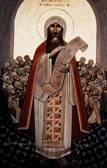St. Athanasius and the Creed
ST. ATHANASIUS AND THE CREED
 Objectives:
Objectives:
- Students should know the story of St. Athanasius and be able to say his name.
- Students should be able to say the first line of the creed.
Possible Lesson Plan:
- Open with prayer.
- Tell the story of St. Athanasius:
Athanasius was born at the end of the third century (How long ago was that?) in the city of Alexandria in Egypt. At that time, Alexandria was an important center of education and learning in the Roman Empire and its bishop an important leader in the Christian Church. One day, the bishop looked out his window and saw some small boys walking back and forth at the seashore. When he asked what they were doing, they said that they have made their friend, Athanasius, their bishop and are following his order to baptize the other children. Athanasius had taught the children all about Jesus and they were ready to follow the Lord! The bishop came to love Athanasius and the boy spent many hours in the bishop’s home reading and studying.
By the time he was 20 years old, Athanasius was writing books about the Lord. He believed that Jesus was truly God as well as truly man. But, another priest in Alexandria, named Arius, believed just the opposite. He believed that Jesus was a “superman” but not really God. He began to tell people that Jesus was a great hero. Even the Emperor Constantine heard of this great disagreement in the Christian Church and was upset by the arguments. So Constantine decided to hold a council of all the bishops. This council was held at Nicea in Asia Minor in 325 AD. Constantine himself was the presiding judge. Athanasius, still a young deacon, spoke to the bishops about the dangers of this new belief that Arius was spreading. Arius also spoke. The Council decided against Arius and wrote a creed, or statement of belief, that says, “Jesus Christ…being of one essence with the Father” to end the disagreement.
Athanasius soon became Bishop of Alexandria. But Arius was still alive and even the Emperor allowed Arius to keep teaching. Then he spread rumors that Athanasius had murdered a man. Athanasius went to Constantinople as a prisoner, but he showed them alive the man he was supposed to have killed! Even so, Athanasius was sent into exile – a prisoner in France for many years. When he finally came home to Alexandria, he again became Bishop. But, when a new Emperor arose who believed with Arius, Athanasius had to escape to Rome. He would try over and over to go back to Alexandria, only to have to flee – finally to the desert. But, he never stopped writing about his beloved Jesus. Finally, as an old man, he was able to go home to Alexandria as its beloved bishop.
Add St. Athanasius to your timeline and, if the timing in the year is right, St. Nicholas, also a particpant in the Council of Nicea.
- Feed the Elephant True/False Questions:
True False
Athanasius was from Alexandria. Athanasius was from Rome.
Athanasius believed that Jesus was God. Athanasius believed Jesus was superman.
Arius believed that Jesus was a hero. Arius believed that Jesus was God.
- Athanasius is called “The Great” by the Church. Why? He defended Jesus against false beliefs for many years. Think a bit about how important it is for Christians to know that Jesus is God. Have the students talk about superman (or spider man, batman, etc.) What are they like? What powers do they have? Are they God? What is different about God? Yes, Jesus was powerful and could walk on water, but His birth, death, and resurrection mean nothing if He was just another superhero!
- Role-play the council: Have one child be Constantine with a gavel. On one side Athanasius and on the other Arius. The rest of the class are bishops. Put on robes from our costume closet if you want. Constantine should pound his gavel. Arius shouts “Jesus is superman!” and Athanasius answers, “Jesus is God and man!” Repeat till the whole class knows the cries of each man.
- Practice the sign of the cross. The three fingers stand for God the Father, the Son, and the Holy Spirit. And the two fingers down on the palm stand for the 2 natures of Jesus – God and man – who came down to earth. Have the students practice. Do they know what the fingers stand for?
- Work on the creed. The memory work for the next few weeks is the Creed for the older classes; the smallest children will only need to know the first line, “I believe in one God the Father Almighty, Maker of Heaven and Earth.”
- Make “Constantine’s Gavel”: Emperor Constantine himself was the judge who ruled at the Council of Nicea. Take a crab mallet. Write on one side, Constantine, and on the other, Council of Nicea. Decorate with paint, glitter glue, etc., or glue on a small picture of Constantine.
OK, crab mallets are not as easy to find as we have them in Baltimore? Make Superman plate – Take a large paper plate. On one side, glue the Superman logo with a large X thru it and write “Arius” underneath. On the other, glue an icon print of either St. Athanasius or of our Lord, maybe from old church bulletins. Turn back and forth, reminding the children of the main issue of the Council of Nicea and its major players.
- Close with prayer: Lord, help me to be strong in what I know is true, even when everyone else disagrees with me.